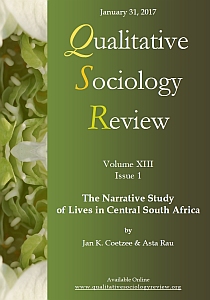Between Society and Self: The Socio-Cultural Construction of the Black Female Body and Beauty in South Africa
DOI:
https://doi.org/10.18778/1733-8077.13.1.10Keywords:
Body, Discourse, Gender, Intersectionality, Positioning, Race/Ethnicity, SubjectivityAbstract
Interested in the socio-cultural construction of the body and beauty, this study investigates the embodied experience of Black African women in South Africa. The Black female body has been problematically positioned in the discourses of beauty. In the dominant, Westernized imagery, the physical markers of blackness such as dark skin and kinky hair have been aesthetically devalued. In the African traditionalist discourses, these body features have been celebrated as beautiful and invoked as the signifiers of cultural pride. This, however, has also been considered as a form of cultural imperative that holds women accountable for how they embody their relationship with their race and ethnicity. Most recently, cultural critics notice the aesthetic revaluation of Black female beauty and ascribe it to the global popularity of the African-American hip-hop culture. In this study, we explore how the socio-cultural complexity of Black female beauty affects the ways in which individuals make sense of their bodies.
Downloads
References
Ahmed, Sarah. 2004. “Affective Economies.” Social Text 2(2):117- 139.
Google Scholar
DOI: https://doi.org/10.1215/01642472-22-2_79-117
Ali, Suki. 2003. Mixed-Race, Post-Race: Gender, New Ethnicities, and Cultural Practices. Oxford: Berg.
Google Scholar
Bellinger, Whitney. 2007. “Why African American Women Try to Obtain ‘Good Hair.’” Sociological Viewpoints 23:63-72.
Google Scholar
Bhabha, Homi. 1990. “The Third Space — Interview with Homi Bhabha.” Pp. 207-221 in Identity, Community, Culture, Difference, edited by J. Rutherford. London: Lawrence and Wishart.
Google Scholar
Brah, Avtar. 2001. “Difference, Diversity, Differentiation.” Pp. 457- 478 in Feminism and Race, edited by Kum Kum Bhavnani. Oxford: Oxford University Press.
Google Scholar
Butler, Judith. 1990. Gender Trouble: Feminism and the Subversion of Identity. New York: Routledge.
Google Scholar
Byrd, Ayana D. and Lori L. Tharps. 2002. Hair Story: Untangling the Roots of Black Hair in America. New York: St. Martin’s Press.
Google Scholar
Candelario, Ginetta E. B. 2007. Black Behind the Ears: Dominican Racial Identity from Museums to Beauty Shops. Durham: Duke University Press.
Google Scholar
DOI: https://doi.org/10.1215/9780822390282
Collins, Patricia Hill. 2004. Black Sexual Politics: African Americans, Gender and the New Racism. New York: Routledge.
Google Scholar
Craig, Maxine L. 2002. Ain’t I a Beauty Queen?: Black Women, Beauty, and the Politics of Race. Oxford: Oxford University Press.
Google Scholar
DOI: https://doi.org/10.1093/acprof:oso/9780195152623.001.0001
Craig, Maxine L. 2006 “Race, Beauty, and the Tangled Knot of a Guilty Pleasure.” Feminist Theory 7(2):159-177.
Google Scholar
DOI: https://doi.org/10.1177/1464700106064414
Crenshaw, Kimberlé. 1989. “Demarginalizing the Intersection of Race and Sex: A Black Feminist Critique of Antidiscrimination Doctrine, Feminist Theory and Antiracist Politics.” The University of Chicago Legal Forum 140:139-167.
Google Scholar
Durham, Aisha S. 2007. Homegirl Going Home: Hip Hop Feminism and the Representational Politics of Location. Doctoral Thesis, University of Illinois, Urbana-Champaign.
Google Scholar
Durham, Aisha S. 2012. “‘Check on It’: Beyoncé, Southern Booty and Black Femininities in Music Video.” Feminist Media Studies 12(1):35-49.
Google Scholar
DOI: https://doi.org/10.1080/14680777.2011.558346
Erasmus, Zimitri. 1997. “Oe! my hare gaan huis toe, Hairstyling as Black Cultural Practice.” Agenda 32:11-16.
Google Scholar
DOI: https://doi.org/10.2307/4066147
Gordon, Doreen. 2013. “A beleza abre portas: Beauty and the Racialised Body among Black Middle-Class Women in Salvador, Brazil.” Feminist Theory 14(2):203-218.
Google Scholar
DOI: https://doi.org/10.1177/1464700113483249
Hooks, Bell. 1995. Killing Rage. New York: H. Holt & Company.
Google Scholar
Hutchby, Ian and Robin Wooffitt. 1998. Conversation Analysis: Principles, Practices and Applications. Cambridge: Polity Press.
Google Scholar
Lara, Ana-Maurine. 2010. “Cimarronas, Ciguapas, and Senoras. Hair, Beauty, Race, and Class in the Dominican Republic.” Pp. 113- 127 in Blackberries and Redbones: Critical Articulations of Black Hair/Body Politics in Africana Communities, edited by R. E. Spellers and K. R. Moffitt. New Jersey: Hampton Press.
Google Scholar
Mercer, Kobena. 1987. “Black Hair/Style Politics.” New Formations 3:33-54.
Google Scholar
Patton, Tracey O. 2006. “Hey Girl, Am I More Than My Hair? African American Women and Their Struggles with Beauty, Body Image, and Hair.” NWSA Journal 18(2):24-51.
Google Scholar
DOI: https://doi.org/10.2979/NWS.2006.18.2.24
Pinho, Patricia. 2006. “Afro-Aesthetics in Brazil.” Pp. 266-289 in Beautiful/Ugly: African and Diaspora Aesthetics, edited by S. Nuttall. Durham: Duke University Press.
Google Scholar
Potter, Jonathan and Margaret Wetherell. 1987. Discourse and Social Psychology. London: Sage.
Google Scholar
Richardson, Elaine. 2007a. “‘She Was Workin Like Foreal’: Critical Literacy and Discourse Practices of African American Females in the Age of Hip Hop.” Discourse & Society 18(6):789-809.
Google Scholar
DOI: https://doi.org/10.1177/0957926507082197
Richardson, Elaine. 2007b. Hip Hop Literacies. New York. Routledge.
Google Scholar
Simien, Evelyn M. 2006. Black Feminist Voices in Politic. Albany, NY: State University of New York Press.
Google Scholar
Spellers, Regina E. and Kimberley R. Moffitt, (eds.). 2010. Blackberries and Redbones: Critical Articulations of Black Hair/Body Politics in Africana Communities. New Jersey: Hampton Press.
Google Scholar
Tate, Shirley A. 2005. Black Skins, Black Masks: Hybridity, Dialogism, Performativity. Aldershot: Ashgate.
Google Scholar
Tate, Shirley A. 2007. “Foucault, Bakhtin, Ethnomethodology: Accounting for Hybridity in Talk-in-Interaction.” Forum Qualitative Sozialforschung / Forum: Qualitative Social Research 8(2). Retrieved October 11, 2015: http://www.qualitative-research.net/index.php/fqs/article/view/247/545
Google Scholar
Taylor, Paul C. 1999. “Malcolm’s Conk and Danto’s Colors; Or, Four Logical Petitions Concerning Race, Beauty, and Aesthetics.” Journal of Aesthetics and Art Criticism 57(1):16-20.
Google Scholar
DOI: https://doi.org/10.1111/1540_6245.jaac57.1.0016
Downloads
Published
How to Cite
Issue
Section
License

This work is licensed under a Creative Commons Attribution-NonCommercial-NoDerivatives 4.0 International License.











